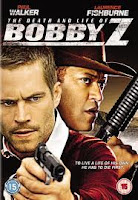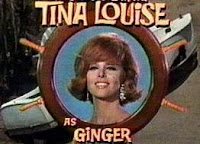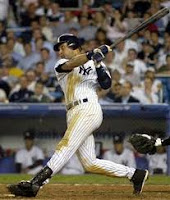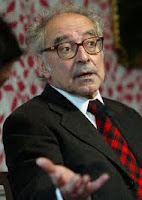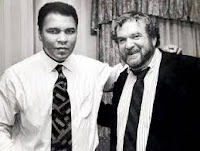 My obituary of Boston sportswriter George Kimball will appear in Monday's Guardian, but it's online now and you can link to it here. I have to confess that I over-wrote the piece; it was very hard to both tell the facts of George's life and convey the brilliant quality of performance art about it within the confines of my original word count, so I called and asked if I could have another 200 words for some stories. Sadly, what was lost in transition to the page was the additional material; since George was one of the most colourful scribes I've ever met, I still wanted to share them. Rather than just adding the anecdotes here, some of which are pretty amazing, the easiest thing to do is simply provide my original take alongside the link to the one published. So here's the original copy (as you notice, I spell hippie the way that doesn't mean someone broad-beamed, although in his later days George was a bit hippy as well as hippie--and I will confess also that I spelled Abbie Hoffman's name 'Abby' in my copy and the Guardian luckily for me corrected it!). I didn't have space to talk about the way George's column at the Phoenix helped make the tribalistic, if not primitive, world of Boston sports accessible for lots of people more concerned with counter-culture than the Red Sox, Celtics, Bruins, or Patriots. Nor did I mention the awards he won later in life--though frankly, I don't need to, because his writing speaks for itself.
My obituary of Boston sportswriter George Kimball will appear in Monday's Guardian, but it's online now and you can link to it here. I have to confess that I over-wrote the piece; it was very hard to both tell the facts of George's life and convey the brilliant quality of performance art about it within the confines of my original word count, so I called and asked if I could have another 200 words for some stories. Sadly, what was lost in transition to the page was the additional material; since George was one of the most colourful scribes I've ever met, I still wanted to share them. Rather than just adding the anecdotes here, some of which are pretty amazing, the easiest thing to do is simply provide my original take alongside the link to the one published. So here's the original copy (as you notice, I spell hippie the way that doesn't mean someone broad-beamed, although in his later days George was a bit hippy as well as hippie--and I will confess also that I spelled Abbie Hoffman's name 'Abby' in my copy and the Guardian luckily for me corrected it!). I didn't have space to talk about the way George's column at the Phoenix helped make the tribalistic, if not primitive, world of Boston sports accessible for lots of people more concerned with counter-culture than the Red Sox, Celtics, Bruins, or Patriots. Nor did I mention the awards he won later in life--though frankly, I don't need to, because his writing speaks for itself.GEORGE KIMBALL, SPORTSWRITER
Ernest Hemingway was reputed to have said 'my writing is nothing, my boxing is everything'. George Kimball, who has died aged 67, wasn't a boxer, but if writing about boxing is the ultimate test of a sportswriter's skill, Kimball deserves a place with the greats.
As a columnist for the Boston Phoenix and Boston Herald, Kimball covered all sports, displaying an uncanny ability to cut through the persiflage and get to the core of a story or a personality. He was that rare bigger-than-life raconteur who could write with the same fluency he spun stories, conveying through the grace of his prose the intimacy of an audience gathered in a smoky bar. A robust figure, with ginger beard and pot belly, chain-smoking Lucky Strikes, indulging his Irish ancestry as if he were a native Bostonian, Kimball was as legendary for his disdain of authority as he was for his ability to meet deadlines no matter how hard the previous night's session had been.
When he was diagnosed inoperable cancer of the oesophagus in 2005, he was given six months to live. He ignored the doctors, continued smoking, and began working to leave behind something less ephemeral than his thousands of columns. One result was Four Kings (2008), the tale of the great middleweights, Marvin Hagler, Thomas Hearns, Ray Leonard, and Roberto Duran, who dominated boxing in the 1980s, its last era of greatness.
oesophagus in 2005, he was given six months to live. He ignored the doctors, continued smoking, and began working to leave behind something less ephemeral than his thousands of columns. One result was Four Kings (2008), the tale of the great middleweights, Marvin Hagler, Thomas Hearns, Ray Leonard, and Roberto Duran, who dominated boxing in the 1980s, its last era of greatness.
That was when I met George, while working for ABC television on its European bouts. Any fight that drew George to Britain, or even better Ireland, became a holiday in itself. The British boxing press recognised one of their own, and to be caught at a bar between George and Hugh McIlvaney, Colin Hart, or Ian Woolridge was, to me, infinitely preferable to further negotiations with promoters or indeed my bosses in New York.
Although George fits in seamlessly with the Runyonesque traditions of great boxing scribes, his route to the daily papers was unique. He came to this hard-boiled field as a literary hippie, typical of his contrarian nature. Born George Edward Kimball III in Grass Valley, California 20 December 1943, his father was an army colonel. George grew up on bases around the world, and entered the University of Kansas on a Navy officer training scholarship. He was soon drawn to campus protest against the Vietnam war. In 1965 he was expelled for picketing the local draft board carrying a sign saying 'fuck the draft'; he'd been arrested for lewd conduct. It was the first of half a dozen arrests. According to Kimball, his father claimed he would have retired a general had his son's anti-war profile not been so high.
retired a general had his son's anti-war profile not been so high.
Having worked on a poetry magazine, Grist, he headed for New York's East Village poetry scene, and got a job at the Scott Meredith Literary Agency, critiquing the work of would-be writers and ghost-writing for Meredith's innumerable books packaged for paperback publishers. His poetry was published in the Paris Review, and in 1967 the famed Olympia Press brought out his only novel, Only Skin Deep, a tongue-in-cheek adult book. He sold pieces to the Village Voice, Rolling Stone and Playboy, but in 1970 returned to Kansas to run for sheriff against the Republican incumbent who'd arrested him in 1965. He ran unopposed in the Democratic primary, as the self-proclaimed leader of the 'Lawrence Liberation Front', used the unwinnable election to indulge in political theatre which included an appearance by Abbie Hoffman.
After the election he moved to Boston and its excellent weekly 'alternative' paper, the Phoenix, part of whose story was told in the movie Between The Lines. His column, 'The Sporting Eye', was an immediate hit, drawing the counter-culture community into Boston's passionate world of sports. Its title referred to his own glass eye, which he claimed to have lost in a youthful bar-room brawl, and which was the punchline to the possibly apocryphal tale of the female reporter who asked George to 'keep an eye on my chair' while she went to the loo. Kimball was renowned for eschewing the Phoenix newsroom in favour of the Eliot Lounge. Famously, he once appeared to drop off copy which was unintelligible, until one editor realised it had to be retyped with every letter moved once space to the left on the keyboard.
Kimball finally quit the Phoenix in 1979 after the millionth confrontation with his editors, bribing a cleaner to open the bar of the Park Plaza hotel at 9am, leaving a colleague at the bar when he disappeared and caught a flight to Florida. He moved to the Boston Herald in 1980, where his columns ran until his retirement in 2005.  In 1997 he began a column, 'America At Large', for the Irish Times; they were collected in a 2008 book published in Ireland alongside his biography of the runner Eamonn Coghlan. After Four Kings, Kimball edited two collections of boxing writing with John Schulin, and published a collection of his own boxing writing, The Manly Art, earlier this year.
In 1997 he began a column, 'America At Large', for the Irish Times; they were collected in a 2008 book published in Ireland alongside his biography of the runner Eamonn Coghlan. After Four Kings, Kimball edited two collections of boxing writing with John Schulin, and published a collection of his own boxing writing, The Manly Art, earlier this year.
Kimball died 6 July 2011 at home in New York. He was married four times, and is survived by a son and daughter by his third wife, Sarah, and by his wife Dr. Marge Marash, whom he married in 2004 in a ceremony conducted by George Foreman. He joked that after sixty years he was finally marrying someone who could write prescriptions for him, and it was too late. It would be wrong to say they don't make them like George Kimball any more, but if they do, they certainly don't let them into newsrooms.

